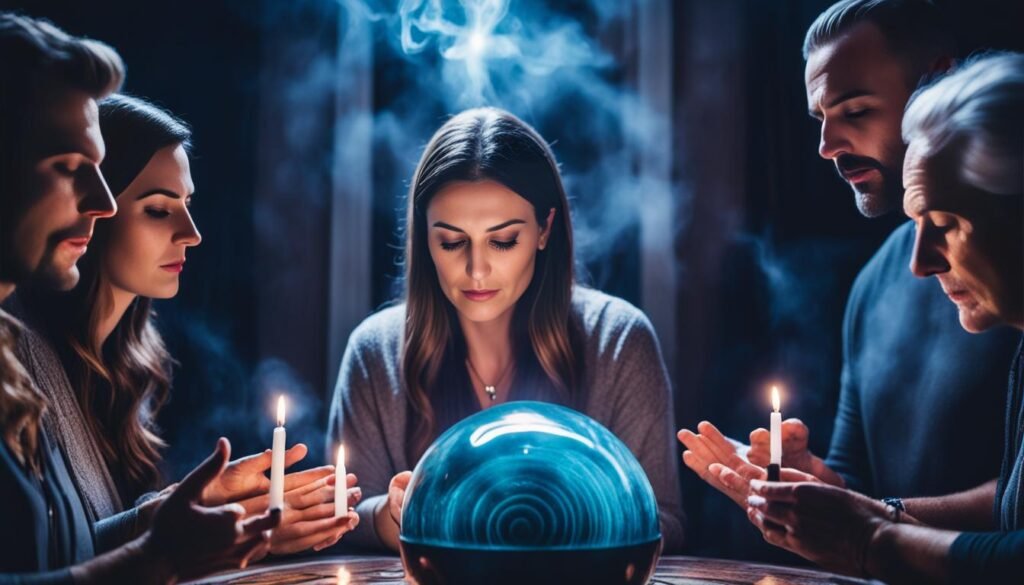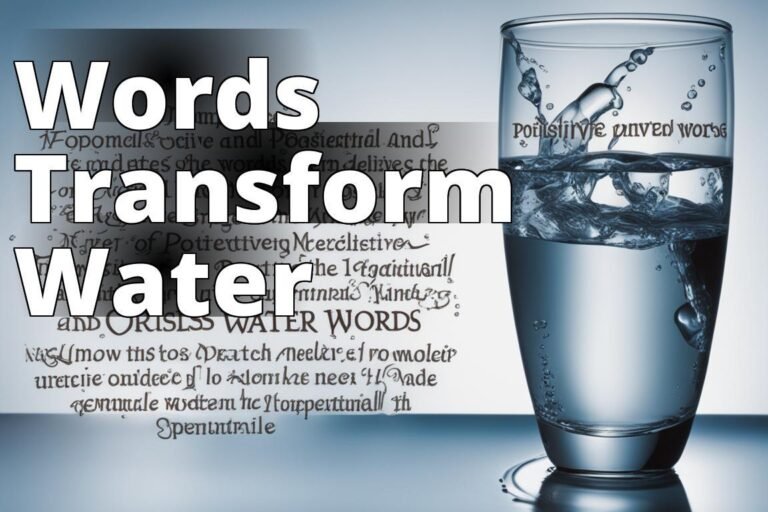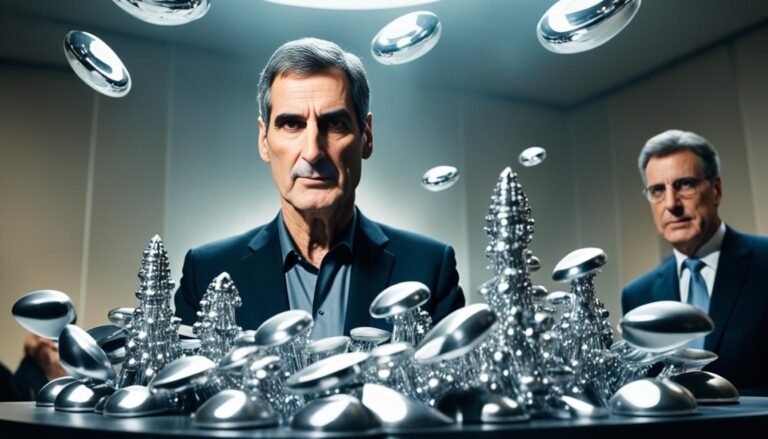Extra Sensory Perception: Our Sixth Sense?
As we tread the fine line between the known and the mysterious, there’s a term that often pops up, stirring curiosity and skepticism alike—Extra Sensory Perception, or ESP. It whispers of a world beyond our physical reach, tickling our fancy for the supernatural. Could it be that we possess a sixth sense, a private channel through which unseen, unheard, and untouched information flows straight to us?
With ESP, we enter a realm splashed with shades of paranormal phenomena and psychic abilities. This is the fabric of intuition and clairvoyance, interwoven with the threads of telepathy, that blankets those who believe they can sense beyond. Our quest for understanding takes us into this vibrant tapestry, daring us to ponder its existence. Are we all privy to this sensational realm, or is it a fable, existing solely in the minds of the hopeful?
Key Takeaways
- Extra Sensory Perception hints at the fascinating possibility of a sixth sense beyond our basic five.
- ESP encompasses a spectrum of psychic abilities, including telepathy, clairvoyance, and intuition.
- The scientific community often meets ESP with skepticism due to its association with paranormal phenomena.
- Despite the skepticism, the allure and enigma surrounding ESP continue to captivate our imagination.
- Unlocking the secrets of ESP could redefine the boundaries of human perception and experience.
- Whether fact or fallacy, the concept of ESP challenges us to expand our understanding of reality.
The Mystique of Extra Sensory Perception
As we delve into the shadowy realms of psychic abilities and paranormal phenomena, we find ourselves wrapped in the enigma of Extra Sensory Perception (ESP). There’s an undeniable charm to the idea that we may harbor senses beyond the conventional five—senses that tune into frequencies unheard and yet profoundly felt. The concept of ESP suggests that clairaudience, the ability to hear beyond the physical, and clairsentience, the capacity to feel what is not physically present, are more than mere folklore.
Gliding through the whispers of empathy, we perceive the subtle emotional currents between us and others. It’s this intrinsic understanding that fuels the belief in a shared, yet hidden, psychological tapestry. And let’s not forget the allure of trans-temporal operation, the notion that some of us might navigate the rivers of time, sensing future ripples or echoes of the past in what’s known as “second sight.” Is it merely a cultural artifact, a story whispered in the Gaelic tales of an dà shealladh, or could it be a veiled truth awaiting scientific unveiling?
- Clairaudience and clairsentience hint at our capabilities to intercept the intangible.
- Empathy, a widely accepted psychological phenomenon, might just be the tip of the iceberg when it comes to understanding ESP.
- Trans-temporal operation invites us to ponder whether time is truly as linear and inflexible as it seems.
While skeptics may eagerly dismiss ESP as a chapter from the book of pseudoscience, the fascination persists. It tickles the intellect, asking whether we’ve missed a hidden chapter of our own sensory evolution. So, we continue to probe the mysteries of the mind, seeking answers in the shadows, ever curious if there’s indeed more to this world than meets the eye—or the other four senses, for that matter.
Historical Insights into ESP Research
Our journey through the brambles of the unknown leads us to the hallowed halls of Duke University, where J.B. Rhine and his wife Louisa E. Rhine planted the seeds of ESP studies in the fertile soil of academia during the 1930s. This pair were akin to psychic horticulturists, diligently cultivating a garden of experimental intrigue with each psychic testing session they conducted.
Beyond the awe that the concept of ESP inspires, its history is riddled with academic skepticism. We should tip our hats to the stalwarts of ESP criticism, who faced significant headwinds in pursuit of this elusive quarry.
The Origins of ESP Studies at Duke University
It was at Duke University where ESP research took off like a rocket, with the Rhines at the helm steering through uncharted cosmic waters. They refined the vague notions of psychic phenomena, crystalizing them into the sharp definitions of ESP and psi. But it wasn’t all just fancy talk—their concoction of Zener cards became an iconic tool in the ESP research arsenal.
Controversies and Academic Skepticism Surrounding ESP
Not all who wandered the academic groves were convinced of the Rhines’ work, however. Like the skeptics of yore, many challenged their findings, debunking what they deemed were experimental design flaws and the notorious issue of sensory leakage. Indeed, these ESP cards became the center of a scientific maelstrom, whipping up controversy with every unfurled symbol.
Zener Cards and the Quantification of Psychic Abilities
Ah, the Zener cards! These simple symbols—circle, square, wavy lines, cross, and star—have danced through countless telepathy experiments, flirted with the concept of clairvoyance, and even toyed with the fickle whims of precognition and psychokinesis. These cards turned the intangible into something approaching the quantifiable, serving as a bridge between the skeptics and the believers.
In our search for historical perspective, we find ourselves both humbled by the Rhines’ pioneering spirit and enlightened by the rigorous scrutiny of subsequent critics. Spontaneous cases and laboratory-controlled parapsychology experiments alike have shaped the narrative of ESP’s contentious walk through the annals of academic research.
Parapsychology: Beyond the Five Senses
As we tiptoe into the unseen corridors of parapsychology, we encounter the whispers of paranormal psychic phenomena, each more mysterious than the last. Here, in this discipline, researchers delve deep into the human psyche, searching for clues to unravel the enigmas of telepathy and other ESP capabilities. Our excursion into this realm is not merely for thrill-seekers, but for the stout-hearted curious minds who dare to dream beyond the tangible world.
It’s in the dim-lit labs where dream telepathy takes the stage, a fascinating phenomenon that beckons the question: Could our nocturnal mind voyages carry messages across the ether? Meanwhile, the Ganzfeld experiments—akin to stepping into a sensory deprivation tank—attempt to strip away the noise of the physical, heightening the senses that reach beyond sight, sound, touch, taste, and smell.
When we speak of ESP, we’re dabbling in the arcane arts of knowledge acquisition, devoid of all physical mediums. It’s the cognitive components of ESP that bewitch us, igniting our quest to decipher the hows and whys of mental telegraphy. Yet, despite our zest, parapsychology often encounters raised brows, standing solitary on the outskirts of mainstream scientific dogma, owing to its elusive nature.
- Parapsychology: a vibrant mosaic of paranormal inquiry, ever-expanding in scope.
- Paranormal psychic phenomena: a kaleidoscope of mysteries, each promising a peek into the beyond.
- Telepathy: the mind’s silent conversation, spoken in the language of thought.
- Dream telepathy: where the subconscious whispers across the void of slumber.
- Ganzfeld experiments: a quest to amplify the whispers of the psyche by muting the world.
- Cognitive components of ESP: the restless gears of the mind, churning in search of connections unseen.
Parapsychology remains an ambitious knight in the exploratory round table, its lance pointed toward the ever-retreating horizon of understanding.
Let us not dismiss or deride, but rather ponder and probe. We stand at the precipice of human experience, gazing into a nebulous abyss, where only the bold dare to leap. May the intangible threads of extrasensory knowledge someday weave seamlessly into the fabric of accepted science.
The Psychic Phenomena Classified as ESP

Embark with us on a spirited jaunt as we unmask the enigmatic gala of phenomena sheltered beneath the moniker of Extrasensory Perception (ESP). Here, the mind’s eye opens wide, perceiving the imperceptible, and the silent whispers of consciousness carry the weight of discourse without uttering a single audible syllable.
These intriguing facets of human experience, often shelved under the banner of ESP, stitch together an elegant yet perplexing tapestry of abilities that some claim to possess. Let’s drape ourselves in this cloak of mystery and explore the niches of psychic sensing that challenge the very foundation of our understood reality.
Clairvoyance: Seeing Beyond Sight
Within the amphitheater of ESP, clairvoyance stands tall, spotlit by intrigue and a storied history of marvels. Picture this: an individual, eyes closed to the world, recounts events unfolding across the globe with startling clarity. Often interchanged with remote viewing, clairvoyance pirouettes on the edges of our perception, offering a viewfinder to the distant. Be it a secluded room or the depths of a forest, the clairvoyant’s gaze knows no bounds, bestowing upon us stories that jolt the skeptical mind.
Telepathy: Mind-to-Mind Communication
Now shift the scene to telepathy, a phenomena often dramatized yet deeply rooted in the annals of paranormal cognition. Beyond the spectacle, it’s a profound elegy to mind-to-mind communication, an intimate tango of thought without the physical clutch of spoken words. Could it be that our brains share a silent language, a network of interlinking thoughts and emotions, baring the soul without a whisper?
Psychometry and Remote Viewing
Whispers in the paranormal gallery speak of psychometry, a curious ability to recount histories with a mere touch. Envision holding a century-old locket and sensing the secret dances it has witnessed, feeling the echoes of laughter and sorrow it harbors. As for remote viewing, skeptics and supporters often lock horns over its legitimacy. Yet those who claim this ability offer accounts of seeing through space, recounting visual symphonies of faraway events with uncanny precision. This brand of psychic phenomena invites us to ponder: are we natural-born cosmic voyagers?
Our soiree through the hallowed halls of psychic phenomena finds us romanced by the serenade of paranormal abilities. Each passageway offers a vista of possible external cognition, urging us to question our sensory boundaries. Can we tap into these streams of ESP research? Do the whispers of psychic sensing stand to rewrite the tome of human capacity? We leave no stone unturned, no psychic sense unexplored, as we peer deeply into the phenomenon that is ESP, tantalized by the endless waltz of the unknown.
Extra Sensory Perception: Understanding Our Paranormal Faculties
As we embrace the realm of the unknown, our quest for understanding treads into the domain of Paranormal faculties and Psychic sensitivities. These riveting aspects of human experience suggest a hidden sea of potential within each of us, awaiting its exploration. From intuition to the more profound experiences of astral projection and out-of-body experiences, the compendium of ESP beckons with its silent siren call.
We’re not just spinning tales of phantasmal encounters here; we’re unraveling the spools of developing ESP that may lay within our very wiring. Imagine, if you will, the possibility of tapping into frequencies that elude the ordinary senses, guiding us through the haze of the everyday to the clarity of the precognitive peaks.
- Understand the nuances of ESP and the multiplicity it entails: from intuition, a subtle nudge towards the unseen, to the more definitive experiences of extrasensory awareness.
- Seek out practices and methods purported to enhance our latent psychic abilities, from meditation to controlled experiments in telepathy and remote viewing.
- Examine the swath of testimonies and anecdotes that persist despite the lack of empirical evidence, narratives that provide a personal lens into the world of ESP.
The inexorable human desire to look beyond has perennially driven us to the precipice of the paranormal, peeking into the abyss of the unexplained. Whether it’s the esoteric ritual of an ancient shaman or the controlled environment of a modern parapsychology lab, the pursuit to harness our psychic sensitivities remains a fascinating facet of our collective curious nature.
But let us cast aside illusions of straightforward answers. The enigmatic fabric of ESP is a complex weave, full of potential threads leading to profound discoveries—or perhaps to dead ends. The intrepid among us continue to assay the perplexing potential of their minds, probing the firmament of consciousness for a signal from the beyond.
So, dear reader, join us as we ponder the perennial question: Are these faculties merely flights of fancy, or do they suggest a tapestry of human ability yet to be fully explored and understood? Our venture into the cryptic sanctum of ESP remains undaunted, ever inspired by the prospect of unearthing the unseen jewels of the human mind.
| Facet of ESP | Description | Potential for Development | Common Practices |
|---|---|---|---|
| Intuition | Sudden, instinctive knowledge or belief without the need for conscious reasoning. | Considered by some to be the most accessible form of ESP, often enhanced through reflective practices like meditation. | Mindfulness exercises, intuitive journaling |
| Astral Projection | The conscious mind or spirit detaching from the physical body to travel in the astral plane. | Can be developed through disciplined practice and is often associated with deep meditative and trance states. | Meditation, guided imagery, trance work |
| Out-of-Body Experiences | The sensation of observing oneself from outside the physical body. | Some report spontaneous experience, while others achieve it through systematic training. | Relaxation techniques, sensory deprivation, hypnotherapy |
| Psychic Sensitivities | A broad term covering a range of perceived psychic abilities, from telepathy to clairvoyance. | Varies widely among individuals; workshops and psychic development groups are common for cultivation. | Energy work, divination practices, psychic circles |
Ah, but we tread carefully, for the landscape is dotted with both the marbles of discovery and the mirages of wishful thinking. Let us journey forth with open minds and a healthy dollop of skepticism, for in the pursuit of paranormal faculties, wisdom often lies in the balance between credulity and critical thought.
ESP in Popular Culture and Media

It’s no secret that the silver screen and the pages of novels shimmer with the arcane allure of precognition and premonitions. We’ve seen it time and again—messages from beyond, warnings of things to come, all touched by the ethereal hand of Extrasensory Perception. Swept up by Pop culture, isn’t it thrilling how films and literature play with the tantalizing possibility of a future foretold?
Precognition and Premonitions in Films and Literature
Beneath the spotlight of mainstream media, precognition and premonitions are not shy of making their grand entrance. Movies like “Minority Report” twist the fabric of time with stories of future-crimes seen before they’re committed. In literature, works such as “The Dead Zone” by Stephen King leap into the minds of readers with the eerie ability to see tragedies before they unfold. Our culture is steeped in stories that dare to speculate, ‘What if?’ and in doing so, ESP portrayal stretches the canvas of creativity, prompting us to question the boundaries of human understanding.
Portrayal of Mediumship and Spirit Communication
Then we have the mediums, the spirit whisperers who claim to straddle the line between this life and the next. Paranormal television series such as “Medium” and “The Long Island Medium” channel the drama of communicating with the departed, shining a prime-time spotlight on Mediumship and Spirit communication. It’s a dance with the unseen, a step into the limelight for Spiritualism, all mediated through a Psychic reading for the living room audience—a veritable spirit spectacle.
Be it through the art of film or the written word, the spell of ESP holds strong, enchanting creators and audiences alike. Whether wrapped in skepticism or clothed in belief, there’s no denying—our fascination with the paranormal persists, echoing through aisles of bookstores and flickering across screens worldwide. So we wonder, in a twist of irony, has society’s dabbling in paranormal fiction primed it for a reality laced with ESP? We’ll leave that mystery for you to ponder.
Scientific Scrutiny and the Skeptic’s View on ESP
As we explore the winding roads of Extrasensory Perception (ESP), we can’t help but bump into the roadblocks of scientific scrutiny. The skeptics are not merely naysayers but gatekeepers of empirical evidence, ensuring that only the scientifically robust may pass. Let’s take a look at why ESP research is often tangled in the thorny brambles of reproducibility and reliability.
In the arena of scientific criticism, ESP faces a heavyweight: replicating experiments. This is the acid test of credibility—one might even call it the ‘open sesame’ for entry into the hallowed halls of established fact. The harsh light of skeptical inquiry is relentless, seeking to cast out shadows of doubt by calling for replication of experiments and consistency of results. Proponents of ESP have the formidable task of catching this will-o’-the-wisp in the net of scientific rigor.
Challenges in Replicating ESP Experiments
Picture a meticulous experimenter, attempting to replicate findings reminiscent of original psi research. Yet, this is no easy endeavor, my friends. There looms a Goliath by the name of methodological flaws—the little inconsistencies, the unintentional biases that creep in like uninvited guests at a masquerade. Sensory leakage and the foibles of human perception often intrude, raising questions of ESP’s veracity and lending strength to the arm of ESP skepticism.
The Role of the James Randi Educational Foundation
Charge forth into the fray and one encounters the James Randi Educational Foundation, a bastion of science and rational thought. With the precision of a surgeon’s scalpel, this foundation cuts through the heart of pseudoscience, challenging those who claim paranormal prowess to prove themselves under the unflinching gaze of controlled conditions. This institution is famous for its ESP challenges—or should we say, infamous among those who struggle to demonstrate their psychic credentials under the bright lights of scientific protocol. In the mission of debunking psychic claims, the Foundation stands as a colossus, its shadow stretching far across the landscape of ESP claims.
| Aspect of Skepticism | Description | Impact on ESP Research |
|---|---|---|
| Replicating Experiments | The requirement for ESP phenomena to be recreated under the same conditions. | Presents a significant hurdle for establishing ESP as a consistent, verifiable phenomenon. |
| Methodological Flaws | Issues in study design that could lead to incorrect conclusions, such as sensory leakage. | Casts doubt on the validity of experimental results and the existence of ESP. |
| Scientific Literacy & Skepticism | The ability to understand scientific concepts and exercise skepticism. | Essential for discriminating between valid paranormal claims and pseudoscience. |
| ESP Challenges | Public tests designed to validate claims of psychic abilities under fair, controlled conditions. | Renews focus on the need for empirical evidence to support the existence of ESP. |
Together, we stand at the precipice, peering over the edge at the chasm between belief and evidence. ESP, with its alluring whispers of a world beyond our sensory grasp, continues to beguile and bemuse. Yet, through the lens of scientific scrutiny and the diligent efforts of organizations like the James Randi Educational Foundation, the pathway to understanding these enigmas is illuminated by the steady light of skeptical inquiry.
The Personal Experience: Tales of ESP Encounters
As we wade through the labyrinth of ESP encounters, it’s the personal experiences, those unbidden flashes of intuition and psychic insight, that often burn the brightest in our collective imagination. These anecdotal evidence stories, complete with premonitory dreams and uncanny telepathic moments, are the stuff of legend. They pepper our conversations and ignite a wildfire of curiosity around the full spectrum of psychic abilities that may lie dormant within us.
Our journey wouldn’t be complete without diving into the vivid tales of the paranormal that have traversed through time, emerging from the murky depths of human experiences with a compelling allure. While they may never stand up in the court of scientific rigor, these tales bind us, whispering of a reality that extends beyond the veil of the five senses.
And so, we find ourselves ensnared by the enigmatic, tantalized by the testimonies of those who have tread the mysterious paths of the paranormal. Are these experiences glimpses of an untapped realm of ESP encounters, mere coincidences cloaked in mystical garments, or perhaps, an evolutionary breadcrumb trail leading us towards an expanded consciousness? These questions hover over us, challenging our grasp of the known world and beckoning us toward the alluring unknown.
FAQ
What exactly is Extra Sensory Perception (ESP)?
Extra Sensory Perception, also known as ESP or the sixth sense, is the purported ability to acquire information without relying on the known physical senses, but rather through a form of intuitive or psychic insight. It encompasses phenomena such as clairvoyance, telepathy, and precognition, tantalizing us with the notion of tapping into an unseen world of information.
How did the study of ESP begin?
The systematic study of ESP took off at Duke University in the 1930s thanks to J.B. Rhine and his wife Louisa E. Rhine. They were pioneers in framing the concepts of ESP and psi, and they conducted experiments attempting to measure these phenomena through various means, like Zener cards, which played a prominent role in telepathy and clairvoyance experiments.
Why is there so much skepticism around ESP?
Critics argue that ESP lacks empirical evidence and cite methodological flaws in experiments, such as sensory leakage, over-reliance on anecdotal evidence, and the inability to replicate findings under controlled conditions. Plus, there’s no established theory to explain how ESP would work, making it a frequent subject of skepticism and often considered a pseudoscience by mainstream scientific communities.
Are there different types of psychic phenomena classified as ESP?
Indeed, there’s quite the variety show of psychic phenomena that falls under the ESP umbrella. Clairvoyance lets you peek into distant events, telepathy involves mind-to-mind chatter, and then you’ve got psychometry, where touching objects spills their historical secrets. Remote viewing takes you on a journey to describe far-off events without needing a ticket to travel.
How has ESP influenced popular culture?
ESP has danced through the spotlight of pop culture, with precognition and premonitions often featured in films and literature, conjuring up the drama of foreseeing the future. Mediumship and spirit communication further thicken the plot in numerous paranormal television shows and media, enticing audiences with the supernatural discourse of reaching beyond the veil.
What challenges do researchers face when studying ESP?
ESP research is like chasing a ghost; it’s tricky to pin down. Reproducing studies with consistent results is a major hurdle, fuelling more fires of skepticism. Many experiments are one-and-done shows that fail to reappear under the scrutinizing eye of replication, and critics quickly jump in with their counterarguments of methodological mishaps and sensory slip-ups.
What’s the James Randi Educational Foundation’s role in the ESP debate?
The James Randi Educational Foundation is like the sheriff in an old western, challenging the wild claims of ESP proponents with a no-nonsense approach to skepticism. This foundation dangles a wagging finger at unsubstantiated psychic claims, promoting scientific literacy and urging a healthy dose of doubt when facing paranormal allegations that lack solid evidence.
Can personal experiences be considered evidence for ESP?
Personal experiences with ESP are as common as finding a haystack in a needle store, but anecdotal accounts don’t quite cut it as evidence in the scientific world. They’re intriguing tales that tickle our curiosity and make us wonder about our own untapped potential, but for the lab coats and clipboards crowd, personal stories don’t meet the gold standards for empirical proof.







